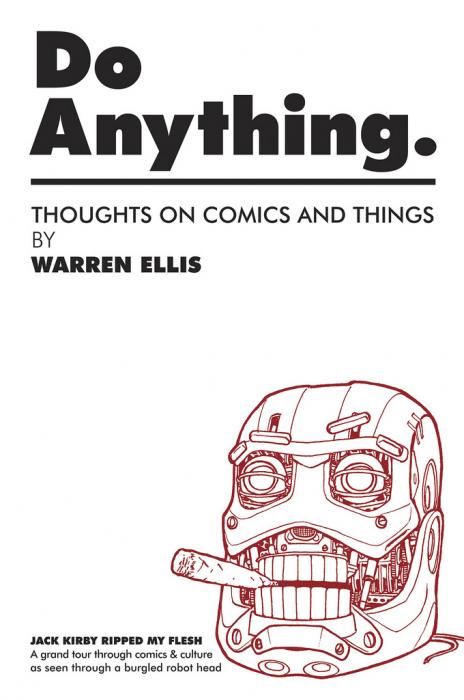"Do Anything" had a somewhat mixed reaction when it was serialized online on Bleeding Cool. A weekly column on comics by Warren Ellis is something that happens every few years, the most notable one probably being his year-long stint here at Comic Book Resources with "Come in Alone," but "Do Anything" was something different. Rather than the straight-forward discussion of the current state of comics that people expect from Ellis, "Do Anything" was a history lesson of sorts revolving around an android head of Jack Kirby that Ellis has in his office. It was rambling and fragmented and disjointed, but it was also a lot of fun. Reading it weekly was an adventure in not knowing where Ellis would go next, but, while reading the serialized version, I always got the sense that it would read even better in collected form, all together, where the larger picture would be easier to see. Thankfully, Avatar Press thought the same thing.
"Do Anything Volume 1: Jack Kirby Ripped My Flesh" collects the 24 "Do Anything" columns from Bleeding Cool, albeit in an altered form. The 24 columns become 15 chapters here as columns are combined and edited to read better on the page. It's a strange journey of freeform connections as Ellis begins with Jack Kirby and moves on from there to Philippe Druillet, George Lucas, Will Eisner, Archie Goodwin, Moebius, David Bowie, and dozens of others. It's an odd mishmash of comics history and pop culture history mixed with Ellis' own flights of fancy and personal anecdotes.
Not quite stream of consciousness, Ellis' writing is similar to a conversational tone. He begins in one place, but the mention of a name sends him off on a tangent, which leads to another tangent and another before he finally returns to where he started. It's winding and very easy to read. However, unlike a conversation, as the chapters begin to pile up, what Ellis is doing becomes apparent: he's drawing connections purposefully, repeating the same ideas with new people. Ultimately, he's showing how Jack Kirby connects to this variety of people, often through nothing more than a date and some similar ideas.
In some spots, he gets a little too fixed into an idea like his continued examples of different people's Superman heads, playing off the redrawing of Kirby's Superman, but, other times, the repetition of ideas works like his list of possible "Do Anything 2" subjects.
The book is lyrical and has its own internal rhythms. Ellis is at his best when he's just spitballing ideas like what Stan Lee would have been like in the Marvel Bullpen back in the day, playing his ocarina and annoying everyone. Or the continued references to architecture as a common ground between people. As Ellis himself says at the end, "This wasn't a complete view of comics, nor was it a detailed one. It was a ride across one part of the landscape, nothing more." That's why I call it conversational. This book feels like Warren Ellis just talking about what interests him and it's entertaining.
"Do Anything" may not be like Ellis's other comics writing, but that wasn't the point. Its charms are its own and it's a unique view of a particular period in comics history through the perspective of one of the medium's top talents. For those that read it when serialized and didn't care for it, it reads much better as a whole. If we're lucky, Ellis will come back for another round as his writing here is marvelous and insightful.

